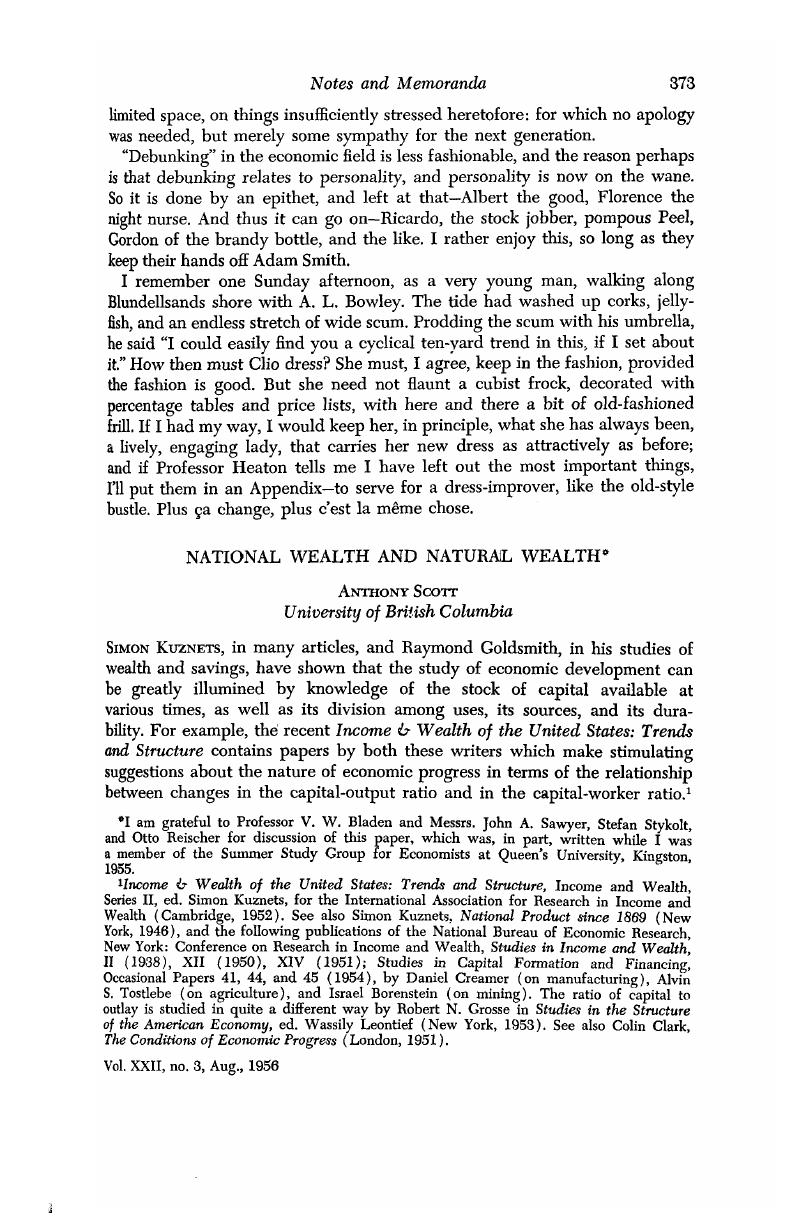Article contents
National Wealth and Natural Wealth*
Published online by Cambridge University Press: 07 November 2014
Abstract

- Type
- Notes and Memoranda
- Information
- Canadian Journal of Economics and Political Science/Revue canadienne de economiques et science politique , Volume 22 , Issue 3 , August 1956 , pp. 373 - 378
- Copyright
- Copyright © Canadian Political Science Association 1956
Footnotes
I am grateful to Professor V. W. Bladen and Messrs. John A. Sawyer, Stefan Stykolt, and Otto Reischer for discussion of this paper, which was, in part, written while I was a member of the Summer Study Group for Economists at Queen's University, Kingston 1955.
References
1 Income & Wealth of the United States: Trends and Structure, Income and Wealth, Series II, ed. Simon Kuznets, for the International Association for Research in Income and Wealth (Cambridge, 1952).Google Scholar See also Kuznets, Simon, National Product since 1869 (New York, 1946)Google Scholar, and the following publications of the National Bureau of Economic Research, New York: Conference on Research in Income and Wealth, Studies in Income and Wealth, II (1938)Google Scholar, XII (1950), XIV (1951); Studies in Capital Formation and Financing, Occasional Papers 41, 44, and 45 (1954), by Daniel Creamer (on manufacturing), Alvin S. Tostlebe (on agriculture), and Israel Borenstein (on mining). The ratio of capital to outlay is studied in quite a different way by Grosse, Robert N. in Studies in the Structure of the American Economy, ed. Leontief, Wassily (New York, 1953).Google Scholar See also Clark, Colin, The Conditions of Economic Progress (London, 1951).Google Scholar
2 According to Weber, B. and Jones, S. J. Handfield, “Variations in the Rate of Economic Growth in the U.S.A., 1869–1939,” Oxford Economic Papers, VI, 06, 1954, 101–31.Google Scholar See also next footnote.
3 According to, among others, Goldsmith (“The Growth of Reproducible Wealth of the United States of America from 1805 to 1950” in Kuznets, , ed., Income & Wealth of the United States, 298)Google Scholar who finds a secular decline since 1929; Fellner, William (“Long-Term Tendencies in Private Capital Formation: The Rate of Growth and Capital Coefficients” in National Bureau of Economic Research, Long-Range Economic Projection, Studies in Income and Wealth, XVI (New York, 1954)CrossRefGoogle Scholar, Table 1, cols. 9 and 10, p. 306) who finds the high point in 1909–18; and Creamer, and Borenstein, who find 1919 to be the high point.
4 See my argument that, from the point of view of capital theory, natural resources are capital, in Natural Resources: The Economics of Conservation, Canadian Studies in Economics, no. 3 (Toronto, 1955), 10–12.Google Scholar
5 See the discussion by Goldsmith, in “A Perpetual Inventory of National Wealth” in Studies in Income and Wealth, XIV, 5–73.Google Scholar A similar perpetual inventory is reportedly under consideration for Canada.
6 “Growth of Reproducible Wealth,” 289. The discussion above should not be interpreted as a defence of the Martin estimates, of which I am ignorant. See the complex criticism of them by Kuznets, in the same volume, 221–39.
7 See the discussion by Kuznets, Income & Wealth of the United States, 79; by Goldsmith, in Studies in Income and Wealth, XIV, 29–33 Google Scholar; and the “Comment” by Kuznets, , Studies in Income and Wealth, XIV, 68.Google Scholar
8 See Gordon, H. Scott, “The Economic Theory of a Common-Property Resource: The Fishery,” Journal of Political Economy, LXII, 04, 1954, 124–42CrossRefGoogle Scholar, and my own comments in “The Fishery: The Objectives of Sole Ownership,” Journal of Political Economy, LXIII, 04, 1955, 116–24.Google Scholar
9 Borenstein, in his comments on the anthracite industry's capital-output ratio and its labour productivity, apparently neglects the effect of depletion (N.B.E.R. Occasional Paper 45, pp. 31, 54).
10 See “A Perpetual Inventory of National Wealth”; since Goldsmith has no figures on annual depletion or discovery of resources to use for his perpetual inventory, he is forced to use other, sample or census, figures to add to his cumulations of tangible wealth. See “Growth of Reproducible Wealth, 29–33, 41. In ”The National Accounts: Whither Now?“ this Journal, XXII, no. 1, Feb., 1956, 77–9, S. A. Goldberg and F. H. Leacy discuss the role that estimates of wealth would play in the National Accounts of Canada. In the same number, Gordon K. Goundrey, in ”Conservation and Capital Theory: A Comment,“ 97, points out that many Canadian capital goods are useful only as long as the depletable natural resources with which they are associated are profitably exploitable. The quantitative importance of this observation would be better understood if some effort were made to measure depletion. The theoretical argument is criticized in my ”Rejoinder," 101, to Professor Goundrey's paper.
11 “Incoine or Welfare,” Review of Economic Studies, XVII, 1949–1950, 85.Google Scholar
- 2
- Cited by




